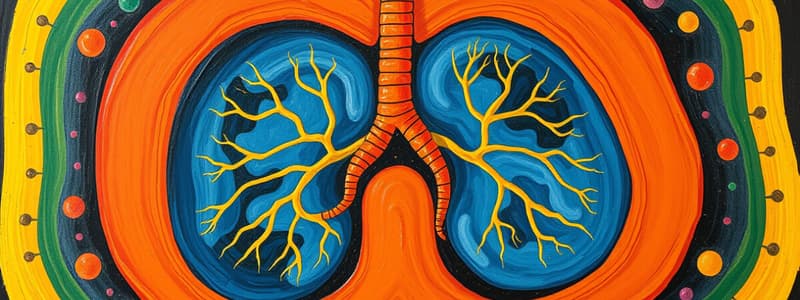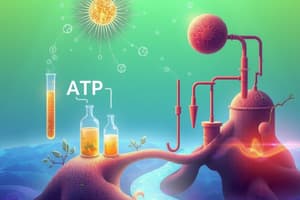Podcast
Questions and Answers
Distinguish between fermentation and cellular respiration.
Distinguish between fermentation and cellular respiration.
Fermentation is the partial degradation of sugars or other organic fuel without oxygen while cellular respiration uses oxygen.
What is the summary equation for cellular (aerobic) respiration? Write the specific chemical equation for the degradation of glucose.
What is the summary equation for cellular (aerobic) respiration? Write the specific chemical equation for the degradation of glucose.
C6H12O6 + 6O2 ---------> 6CO2 + 6H2O + energy
Define oxidation and reduction.
Define oxidation and reduction.
Oxidation is the loss of an electron; reduction is gain of an electron.
How are redox reactions involved in energy exchanges?
How are redox reactions involved in energy exchanges?
What is the role of NAD+ in cellular respiration?
What is the role of NAD+ in cellular respiration?
Explain the role of the electron transport chain in cellular respiration.
Explain the role of the electron transport chain in cellular respiration.
Name the three stages of cellular respiration and state where each occurs in a eukaryotic cell.
Name the three stages of cellular respiration and state where each occurs in a eukaryotic cell.
How does the carbon skeleton of glucose change during glycolysis?
How does the carbon skeleton of glucose change during glycolysis?
Why is ATP required for the preparatory steps of glycolysis?
Why is ATP required for the preparatory steps of glycolysis?
Where do substrate-level phosphorylation and the reduction of NAD+ occur in glycolysis?
Where do substrate-level phosphorylation and the reduction of NAD+ occur in glycolysis?
Describe where pyruvate is oxidized to acetyl CoA and how this links glycolysis to the citric acid cycle.
Describe where pyruvate is oxidized to acetyl CoA and how this links glycolysis to the citric acid cycle.
What are the products of the citric acid cycle and why is it called a cycle?
What are the products of the citric acid cycle and why is it called a cycle?
At what point is glucose completely oxidized during cellular respiration?
At what point is glucose completely oxidized during cellular respiration?
Distinguish between substrate-level phosphorylation and oxidative phosphorylation.
Distinguish between substrate-level phosphorylation and oxidative phosphorylation.
Explain how the exergonic 'slide' of electrons is involved in energy production.
Explain how the exergonic 'slide' of electrons is involved in energy production.
Flashcards are hidden until you start studying
Study Notes
Fermentation vs. Cellular Respiration
- Fermentation occurs without oxygen, partially degrading organic fuels like sugars.
- Cellular respiration requires oxygen and fully breaks down glucose.
Summary Equation for Cellular Respiration
- General formula: C6H12O6 + 6O2 → 6CO2 + 6H2O + energy.
- Specific chemical equation reflects the complete conversion of glucose.
Oxidation and Reduction
- Oxidation: Loss of electrons.
- Reduction: Gain of electrons.
Role of Redox Reactions
- Electrons transfer between atoms, often moving to lower energy states during covalent bond alterations.
NAD+ in Cellular Respiration
- NAD+ acts as an electron and hydrogen carrier.
- It is a site for dehydrogenase enzymes to transfer electrons during oxidation-reduction reactions.
Electron Transport Chain
- Electrons are passed from NADPH to the electron transport chain.
- This process culminates in the formation of water by combining electrons with hydrogen ions and oxygen.
Stages of Cellular Respiration
- Stages: Glycolysis, Citric Acid Cycle, Oxidative Phosphorylation.
- Glycolysis occurs in the cytosol; Citric Acid Cycle and Oxidative Phosphorylation occur in the mitochondrial matrix.
Changes in Glucose During Glycolysis
- The glucose ring opens, and glucose is cleaved into two straight-chain 3-carbon molecules (glyceraldehyde).
ATP in Glycolysis Preparatory Steps
- Two ATP are consumed when glucose splits into glyceraldehyde 3-phosphate.
- This conversion leads to the production of two NADH and four ATP through substrate-level phosphorylation.
Substrate-Level Phosphorylation in Glycolysis
- Takes place in Reactions 7 and 10 where substrates transfer phosphate to ADP to form ATP.
- Phosphate groups originate from ATP hydrolysis in endergonic reactions.
Oxidation of Pyruvate to Acetyl CoA
- Occurs in the presence of oxygen for aerobic respiration.
- NADH is involved, linking glycolysis to the Citric Acid Cycle through acetyl CoA production.
Products of the Citric Acid Cycle
- Produces CO2, NADH + H+, and FADH2.
- It is termed a cycle as citrate is formed from acetyl CoA and oxaloacetate, then oxidized back to regenerate oxaloacetate.
Complete Oxidation of Glucose
- Glucose is fully oxidized when energy has been transferred to 6 NADH and 2 FADH2.
Substrate-Level vs. Oxidative Phosphorylation
- Oxidative phosphorylation uses a proton motive force (PMF) to produce ATP via ATP synthase.
- Substrate-level phosphorylation directly synthesizes ATP through the transfer of phosphate groups during glycolysis.
Studying That Suits You
Use AI to generate personalized quizzes and flashcards to suit your learning preferences.




